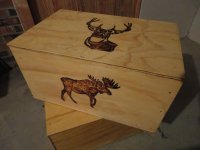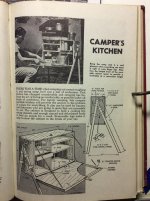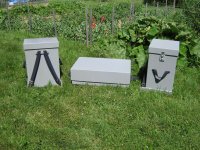Hello All
As background, I don't intend to be on any (or darn few) portages of any long distance. Most trips would be base camping (with day trips) and rarely more then 6-7 days in duration. And there will usually only be two of us.
I've been thinking about making a chuck box/wannagan for a bit and would appreciate any insights or advice. I've made a number of boxes for Boy Scout patrol boxes and family camping but as none of them had any risk of sitting in water I'm going back to the drawing board. Besides, the two we had left went to our kids when we downsized so now I have an excuse to try something new.
I'd kind of thinking along the lines of something loosely based on the BSA patrol box picture below, sized for a double canoe, with a more refined version of the adjustable height legs (running in aluminum c-channel) like the box in the second picture along with leg storage inside or under the box. I'm thinking of using either 3/8"/9mm or 1/4"/6mm Baltic birch plywood for the carcass and 1/4" for shelves and dividers. The rough weight of 1/4" Baltic birch plywood is 0.8 pounds per square foot and 3/8" is around 1.2 pounds per square foot so I suspect that once I have a drawing I'll figure out the approximate empty weight before deciding on which to use.
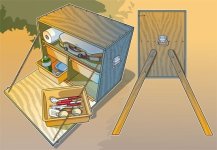
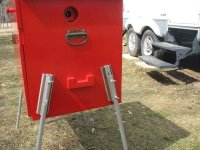
My target for the largest stove carried would be a two-burner Coleman liquid fuel stove although maybe I'd opt for the lighter flimsy modern ones if I have to carry this thing more than a few hundred yards. My Coleman (EDIT: changed from 425G to) 413G and 426C are great stoves but probably weigh twice as much as the soda can thin new ones and are much larger. The front flap and the top of the box would be available as work/cooking surfaces and the legs would get the stove to a comfortable height. Although I like using dish pans to hold things I'd put them on shelves instead of using them as suspended drawers as that leaves you nowhere to put the contents when you are using the dishpan. Add beveled cleats to the sides as handles (and maybe to attach a tumpline) and a pair of cleats under it to raise it bit off the floor of the canoe so it isn't always sitting in water.
So, that leads me to the big challenge; sealing the front flap to keep it watertight. After a lot of thought I am pretty sure that using an EPDM closed cell foam bulb seal (link below) would do the trick when pared with some adjustable latches (also linked below) on the side (and maybe the top edge) to pull the flap tight to the seal.
https://www.mcmaster.com/93085k12
https://www.mcmaster.com/1864a17
I'm a longtime finish and trim carpenter and sometime custom cabinet maker. I have no intentions of dovetailing this thing but for the most part, if I can imagine, it I can build it.
And now I'd appreciate your thoughts.
My thanks and best regards to all,
Lance
As background, I don't intend to be on any (or darn few) portages of any long distance. Most trips would be base camping (with day trips) and rarely more then 6-7 days in duration. And there will usually only be two of us.
I've been thinking about making a chuck box/wannagan for a bit and would appreciate any insights or advice. I've made a number of boxes for Boy Scout patrol boxes and family camping but as none of them had any risk of sitting in water I'm going back to the drawing board. Besides, the two we had left went to our kids when we downsized so now I have an excuse to try something new.
I'd kind of thinking along the lines of something loosely based on the BSA patrol box picture below, sized for a double canoe, with a more refined version of the adjustable height legs (running in aluminum c-channel) like the box in the second picture along with leg storage inside or under the box. I'm thinking of using either 3/8"/9mm or 1/4"/6mm Baltic birch plywood for the carcass and 1/4" for shelves and dividers. The rough weight of 1/4" Baltic birch plywood is 0.8 pounds per square foot and 3/8" is around 1.2 pounds per square foot so I suspect that once I have a drawing I'll figure out the approximate empty weight before deciding on which to use.


My target for the largest stove carried would be a two-burner Coleman liquid fuel stove although maybe I'd opt for the lighter flimsy modern ones if I have to carry this thing more than a few hundred yards. My Coleman (EDIT: changed from 425G to) 413G and 426C are great stoves but probably weigh twice as much as the soda can thin new ones and are much larger. The front flap and the top of the box would be available as work/cooking surfaces and the legs would get the stove to a comfortable height. Although I like using dish pans to hold things I'd put them on shelves instead of using them as suspended drawers as that leaves you nowhere to put the contents when you are using the dishpan. Add beveled cleats to the sides as handles (and maybe to attach a tumpline) and a pair of cleats under it to raise it bit off the floor of the canoe so it isn't always sitting in water.
So, that leads me to the big challenge; sealing the front flap to keep it watertight. After a lot of thought I am pretty sure that using an EPDM closed cell foam bulb seal (link below) would do the trick when pared with some adjustable latches (also linked below) on the side (and maybe the top edge) to pull the flap tight to the seal.
https://www.mcmaster.com/93085k12
https://www.mcmaster.com/1864a17
I'm a longtime finish and trim carpenter and sometime custom cabinet maker. I have no intentions of dovetailing this thing but for the most part, if I can imagine, it I can build it.
And now I'd appreciate your thoughts.
My thanks and best regards to all,
Lance
Last edited:

